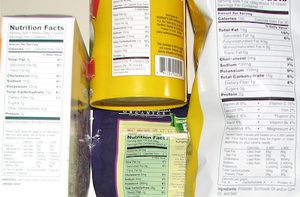Clarity in food product labels, is it important?
Posted by Elena del Valle on March 24, 2010

Food product labels include a list of ingredients
Photo: HispanicMPR.com
Can you tell which of the following four sweeteners, fructose, dextrose, sucralose and acesulfame potassium, is natural and which is artificial? If you know that the first two are natural sugars and the other two are artificial sugars you may be among 4 percent of surveyed respondents who knew the answer. The other 96 percent were not be able to identify the difference. Knowing what ingredients are contained in a product only helps, some advocates of enhanced food products labeling argue, if consumers know what the ingredients are.
If, like in this artificial versus natural sweeteners example, they don’t know a natural sweeter from any other ingredient listing the ingredients may offer few insights when consumers are making purchasing decisions based on nutritional content. Experts point out that often consumers have heard of the brand names like Equal but do not know the generic name like aspartame.
The confusion may be aggravated by the significant increase in sweeteners since labeling regulations began. Where there used to be five sweeteners there are now 27, according to a recent The Palm Post article. In 2005, the Sugar Association filed a petition with the Food and Drug Administration (FDA) requesting a labeling change to make it clear to buyers when there are artificial sweeteners in a product. A study, conducted by Harris Interactive and commissioned by the Sugar Association, indicates most parents of children 18 and younger prefer to avoid artificial sweeteners for their children.
With the high incidence of diabetes, obesity and chronic diseases related to dieting some believe truth and clarity in labeling are more important than ever. Among Latinos many of whom are at high risk of diabetes (see Exercise specialist, researcher explore diabetes issues relevant to Latinos) the issue may be aggravated by cultural practices and preferences and labeling, especially of chemical sounding and unfamiliar ingredients, may do little to help. That is not even taking into account Spanish dominant Latinos who have difficulty reading labels in English.
Executives at the Center for Science in the Public Interest are so convinced of the public confusion about labels that in December 2009 they sent a 150-page report, Food Labeling Chaos: the Case for Reform, to the FDA about false and misleading food labels. The report emphasizes three problem areas: the Nutrition Facts Panel, ingredient labels and false and misleading health-related claims.
They highlight a cereal (Kashi, owned by Kellogg) that promises “healthy arteries” from green tea ingredients although there is no FDA approval of such a relationship (between green tea and healthy arteries); an English muffin brand (Thomas’ Hearty Grains English Muffins) that touts whole grain although the main ingredient is “unbleached enriched wheat flower;” and fruit juices (Gerber Graduates Juice Treats) with pictures of fruits on the labels that are not contained in the juices.
The Center for Science in the Public Interest dual missions are to “conduct innovative research and advocacy programs in health and nutrition, and to provide consumers with current, useful information about their health and well-being.”









